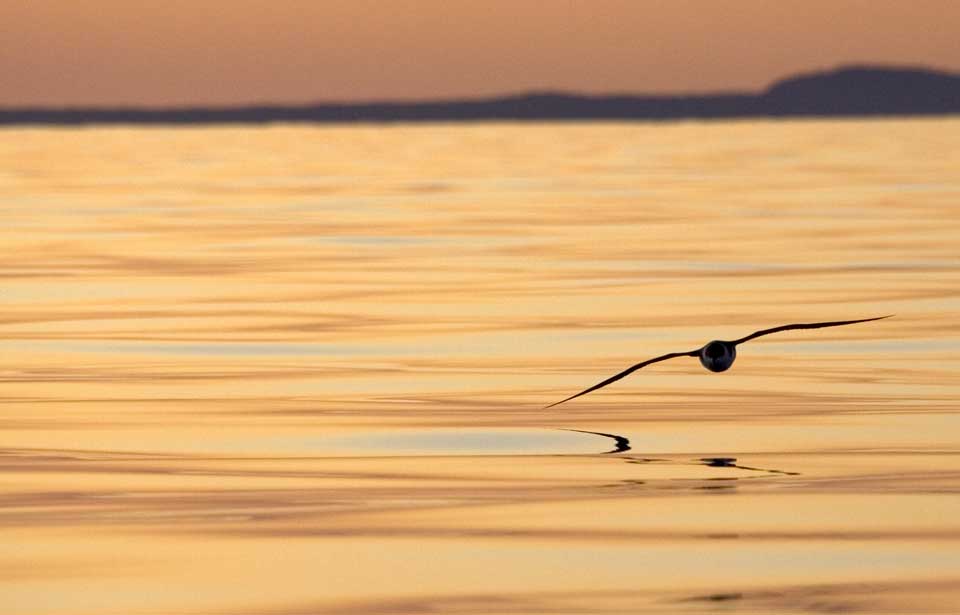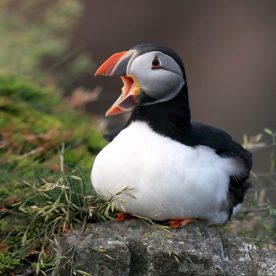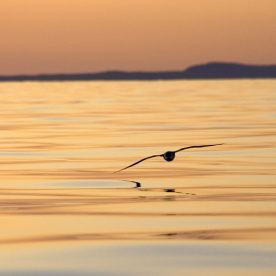Description

Common Tern
Everyone who has visited the coast is familiar with gulls, those graceful, long-winged birds that throng the beaches and harbours and boldly beg for scraps. The gulls are a family of birds that live mainly at sea, either along the shore, or out in the ocean itself. Worldwide, there are more than 350 species of birds that live either partially or exclusively at sea, and these are generally known as “seabirds.”
The table below lists the 14 families of marine birds and the approximate number of species in each (the exact number of species is continually being revised as genetic research reveals that some very similar-looking birds are so different in their genetic makeup that they constitute different species). All species belonging to the albatross, auk, frigatebird, gannet, penguin, petrel, and storm-petrel families feed exclusively at sea. In addition, many species of cormorants, grebes, gulls, jaegers, loons, pelicans and terns feed either entirely or mainly at sea. The Phalaropes are the only shorebirds that feed at sea.
Families of birds in which all species feed either entirely of partially at sea and the approximate number of species in each family appear below (from http://www.worldbirdnames.org/ioc-lists/master-list/). The number of species that breed in Canada are shown in parentheses. Ducks and grebes that feed at sea are not included.
Number of species
|
Family |
Wholly marine |
Partially marine |
|
Albatrosses |
21 |
|
|
Auks |
24(13) |
|
|
Boobies/gannets |
10(1) |
|
|
Cormorants |
28(4) |
13(1) |
|
Frigatebirds |
5 |
|
|
Gulls, terns and skimmers |
68(8) |
44(11) |
|
Loons/divers |
5(4) |
|
|
Pelicans |
1 |
7(1) |
|
Penguins |
18 |
|
|
Petrels |
96(2) |
|
|
Phalaropes |
|
3(3) |
|
Skuas/jaegers |
4 |
3(3) |
|
Storm-petrels |
24(2) |
|
|
Tropicbirds |
3 |
|
|
Total |
302(30) |
75(23) |
Habitat and Habits
Two thirds of Earth is covered by water but seabirds constitute only three percent of the world’s bird species. This is probably because, in the sea, many of the roles that birds play on land are performed by fishes.
Although seabirds are highly visible from coasts and at sea, most people do not think of birds as sea creatures in the same way that they think of whales or seals. Because many seabirds spend most of their time flying above the sea surface or perching on rocks and islands, and because they must return to land to breed, they do not qualify as genuine marine organisms in many people’s minds. Nevertheless, many of them derive all their food from the sea, and because of this they form an important part of the marine food web: the sea is their home as much as it is for crabs and corals.
Unique characteristics

Sooty Shearwaters
True seabirds – those that spend all their lives at sea except when breeding – are among the most far-ranging of all birds. For example, Northern Fulmars in the Canadian high Arctic may travel more than 500 km from their breeding colony to find food during the breeding season, while the foraging trips of large albatrosses may cover several thousand kilometers. Oceanic seabirds are amazingly unaffected by storms and waves. The large albatrosses are actually dependent on strong winds to allow them to glide the enormous distances that they need to cover in order to find their food. However, a prolonged period of adverse weather conditions, especially in winter, can exhaust the energy reserves of some birds, resulting in their being washed up exhausted on beaches, or even driven far inland. Certain species are famous for such periodic “wrecks.” In eastern North America showers of Dovekies appear inland at irregular intervals, apparently as a result of an adverse combination of strong winds and poor food supplies.
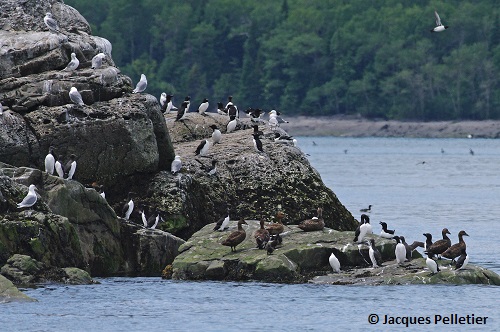
Several species of seabirds in a colony
Some seabirds are highly adapted for underwater swimming, using either their wings (auks, penguins, shearwaters) or their feet (cormorants, loons) for propulsion. The deepest diver is the 30-40 kg Emperor Penguin, which goes as deep as 300 m and spends up to 10 minutes submerged. Among auks, the comparatively small murres (1 kg) can dive to 150 m. Penguins have hair-like feathers which do not trap much air. Consequently, they manage to maintain a density close to that of water. Auks, by contrast, are well-feathered so that they are positively buoyant because of air trapped in their plumage and must swim against buoyancy to descend. However, the negative effect of buoyancy reverses as they ascend and they travel upwards much faster than they descend. Birds depend on stored oxygen while diving and this is carried in the blood cells, in the lungs and in air sacs in the body cavity. A diving bird will adjust the amount of air taken in before a dive so that its buoyancy is appropriate for the depth it aims to forage at. It also shuts down all metabolic activity except that needed by the diving muscles to reduce the rate at which oxygen is used. These adaptations allow the comparatively tiny murres to dive for up to 4 minutes –longer than most people can manage.
In general, underwater-feeding seabirds are less common in tropical waters than in polar and temperate waters. For instance, the distribution of the penguins, a family of birds found only in the southern hemisphere, reaches as far north as the equator only in the Galapagos Islands, where the Humboldt Current maintains relatively cool water. The range of the auks—northern hemisphere equivalents of the penguins—extends into tropical waters only in California and on the Pacific coast of Mexico, areas affected by the cool California Current. The lack of diving birds in the tropics, where there are many surface-feeding petrels and terns, may be due to competition or predation from large fishes that thrive in warmer waters.
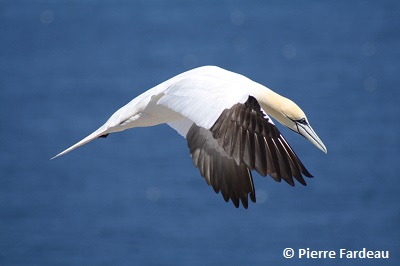
Northern Gannet
As well as underwater swimming, many seabirds, such as storm-petrels, terns, and jaegers, feed at the sea surface, seizing prey in flight. Others, including kittiwakes, phalaropes, and Northern Fulmars, feed while sitting on the water. Species such as gannets, boobies, pelicans, and terns use the impetus derived from plunging vertically into the sea to carry them underwater. Gannets dive from heights of up to 50 m above the surface to reach depths of as much as 15 m. However, most seabirds feed within 1-2 m of the sea surface, gleaning floating material, or feeding on organisms swimming at very shallow depths. Differences in feeding techniques have led to a variety of seabird designs. The following drawing shows the silhouettes of some of the families and species found off the island of Newfoundland. Notice the long wings of the surface-feeding gull and tern compared to those of underwater swimmers: puffin, murre and razorbill.
Characteristic silhouettes of common seabirds of the western North Atlantic(drawing by Ian Jones)

- American Robin (for scale);
- Northern Gannet;
- Herring Gull;
- Parasitic Jaeger;
- phalarope;
- tern;
- Razorbill (auk family);
- cormorant;
- murre (auk family);
- puffin (auk family);
- Dovekie (auk family);
- Black Guillemot (auk family);
- shearwater (petrel family);
- Leach’s Storm-Petrel;
- Wilson’s Storm-Petrel;
- Common Eider (duck family);
- Oldsquaw (duck family)
Range
Seabird distributions tend to be much affected by the local conditions, such as water temperature, depth, and currents, in different parts of the oceans. Seabirds are more numerous in polar than in tropical waters, and there is a greater diversity in the southern hemisphere than in the northern, probably because much more of the southern hemisphere consists of ocean. In Canada, the greatest diversity is found off the island of Newfoundland. There, at the edge of the Grand Banks, the cold waters of the southward-flowing Labrador Current meet the warm waters of the Gulf Stream, which supports an entirely different array of animals, including many seabirds characteristic of more southerly latitudes.
On the Grand Banks, birds that breed in the Arctic and Subarctic, such as murres and Atlantic Puffins, intermingle with birds that breed in more temperate regions, such as shearwaters, gannets, and storm-petrels. The coastal waters of British Columbia, although farther north than those off Newfoundland, are warmed by northward-flowing currents and hence support only seabirds that breed and winter in temperate climates, such as Cassin’s and Rhinoceros auklets.

Many seabird populations are very numerous. Among those that breed in the southern hemisphere, Wilson’s Storm-Petrels, Sooty and Short-tailed shearwaters and Fairy Prions number in the tens of millions. In the northern hemisphere, Leach’s Storm-Petrel, Common and Thick-billed murres, Atlantic and Tufted puffins, and the Dovekie also have populations exceeding 10 million birds. Canada alone supports more than five million Leach’s Storm-Petrels, most of them in Newfoundland, more than two million Thick-billed Murres, most in the eastern Arctic, and more than 1.5 million Cassin’s Auklets, more than half of which breed in one colony, on tiny Triangle Island, British Columbia.
Like whales, seabirds are highly mobile and many of them undertake regular seasonal migrations (see map). Seabird migrations include the longest recorded for any bird: the Arctic to Antarctic migration of the Arctic Tern, and the spectacular circuit of the Pacific Ocean made by Sooty Shearwaters breeding in New Zealand. Almost equally impressive, for a relatively weak flier, is the migration of the Pacific Loon from breeding areas in the central Canadian Arctic, along the north coast of Alaska, through the Bering Strait, and south to waters off California. The tiny Wilson’s Storm-Petrel, no heavier than a starling although with much longer wings, makes an annual trip from its breeding places in the sub-Antarctic to spend the Austral winter in waters off Nova Scotia.
Among seabirds breeding in Canada, those nesting in the eastern Arctic spend the winter mainly off Newfoundland and Labrador and Nova Scotia, or farther south in the Atlantic. Those breeding on the coasts of the Beaufort Sea and in the central High Arctic mainly spend the non-breeding season in the Pacific. Many species are split into eastern and western populations that spend the non-breeding season respectively, in the Atlantic and Pacific (Thick-billed Murres, Red-throated Loons).
Feeding
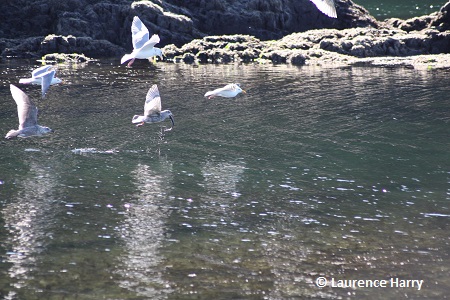
Herring Gulls feeding
Most seabirds feed either on small fishes or on zooplankton, the small, mainly crustacean, or shelledorganisms that browse the oceans’ primary producers, the microscopic plants called phytoplankton. Seabirds tend to be generalized in their diet, taking a wide spectrum of different sizes and types of prey. However, while rearing chicks they are more selective. Murres and puffins, for instance, take a very diverse diet, but feed their chicks exclusively on fish. In some situations a particular species of fish may become dominant in the diet. In the northwest Atlantic, for instance, the capelin, a small schooling smelt, is important to most seabirds, as well as to cod and marine mammals. In the Arctic, the Arctic cod, a small relative of the Atlantic cod that occurs in enormous schools in Arctic waters, is the main prey of many seabird species. In British Columbia waters the sandlance, a species of fish, is similarly important. Where birds are very dependent on a single type of prey the potential for disruption of their food supplies through human exploitation is high.
Many seabirds travel constantly in response to changes in weather and food supply. Their food is often very patchily distributed, requiring them to search enormous areas to be sure of finding it. When a patch, such as a school of fish at the surface or a dead whale, is located, the food may be very easy to obtain, and the birds gorge themselves until they can scarcely take off. Compared with many land birds, therefore, most seabirds are accustomed to alternations of feast and famine.
Breeding

Atlantic Puffin nesting
The general affinity between seabirds and cold water makes Canada a good place for seabirds to live. Fifty species breed here and a further 20 or more that breed elsewhere feed in Canadian waters for part of the year. On a world scale, Canada is especially well endowed with loons, phalaropes, jaegers, and auks. The coast of British Columbia supports more than half the world population of three auks: the Ancient Murrelet, Cassin’s Auklet, and the Rhinoceros Auklet.
The nutrient-rich arctic marine waters off eastern Newfoundland are especially attractive to seabirds. Many of those that breed in the eastern Atlantic visit Newfoundland and Labrador in winter, along with most murres, kittiwakes and gulls breeding in the eastern Arctic and the majority of the world’s Dovekies, which breed in northwest Greenland. In addition, many Black-legged Kittiwakes and Northern Fulmars reared in the eastern Atlantic spend both summer and winter off Newfoundland during their prebreeding years. The shallow waters of the Grand Banks provide a nursery area for them. In summer also, millions of Greater and Sooty Shearwaters from the southern hemisphere come to spend their nonbreeding season. The total numbers of seabirds on the Grand Banks at any time therefore greatly exceeds the local breeding population. The birds, like the European fishing fleets of earlier centuries, come to exploit some of the most productive waters in the world. The health of the marine ecosystem off Newfoundland and Labrador is important for seabirds from the entire Atlantic Ocean.
Conservation

Red-throated Loon
Seabirds and their eggs have been an important source of food for coastal people around the world for millennia. Some communities, like that of St. Kilda in the western isles of Scotland, were almost totally dependent on harvesting seabirds. In Canada, seabirds were an important constituent of native diet in British Columbia, in Newfoundland and Labrador, and throughout the eastern Arctic, where every major colony is accompanied by archaeological remains attesting previous use. In the Arctic, the Thick-billed Murre was the most commonly taken species. At Digges Island in northern Hudson Bay, one of Henry Hudson’s crew described finding stone huts containing murres “hanged by the neck;” the remains of the huts are still visible on the island. The Inuit name of a nearby headland translates as “the place of beating with sticks,” recalling the early method of killing the birds as they flew over.
Seabird eggs are harvested worldwide, as they provide a good source of protein neatly packaged in a convenient container and they keep for weeks or even months if stored properly. In addition, careful harvesting, where only a proportion of eggs are taken, has little effect on populations. Murre eggs are an important food source for certain Inuit communities in Canada. The eggs of gulls and terns were taken by native peoples throughout Canada.
Unfortunately, after the arrival of Europeans, the introduction of commercial egg harvesting, with thousands of eggs being removed to towns and cities for sale, led to overexploitation and drastic reductions in populations. This damage was halted by the Migratory Birds Convention, signed in 1916 with the United States, which provided protection for most migratory birds, including gulls and terns. Populations of gulls, especially, have since rebounded in a spectacular fashion, in part because of abundant food in the form of human garbage and fish offal, or leftover waste from the fishing industry.
In addition to their use for food, seabirds were harvested in the past for feathers. This was the ultimate cause for the extirpation, or extinction in a specific area,of the Great Auk from its most important colony, on Funk Island, Newfoundland and Labrador. Gannets and terns were also much reduced by the feather industry in the early 20th century.
Seabirds, like most of the world’s animals, have suffered enormous disruptions to their habitats and populations as a result of the human tendency to use most of Earth’s resources for ourselves. Direct harvesting, especially during the period of the great European mercantile expansion in the 16th to 19th centuries, led to the extinction of the Great Auk in the Atlantic and of Pallas’ Cormorant in the Pacific, as well as the reduction or extirpation of many local seabird populations.

Double-crested Cormorant
More important, though less obvious, was the impact of human camp followers such as pigs, cats, and rats, and of deliberate introductions of foxes and other carnivores for fur farming. Seabirds are aggressive predators when at sea, but on land they had evolved over millennia on islands without mammalian predators. If predatory mammals arrive, many seabirds find it impossible to adapt their behaviour rapidly enough to cope with the new threat.
It is likely that the Polynesian rat, spread to many Pacific islands, including Hawaii, by the canoes of the early Polynesians, caused major seabird extinctions before science had a chance to record them. The subsequent effects of ship and Norway rats, spread by Europeans, are better documented. In Canada, these two species were responsible for the decimation of the formerly enormous seabird colony at Langara Island in British Columbia. However, in 1995, a major initiative by Environment Canada’s Canadian Wildlife Service resulted in the total eradication of rats from this island. We hope that the removal of the rats will result in the eventual restoration of its seabird populations. Sadly, some introductions are still underway, with the continuing advance of raccoons in Haida Gwaii (Queen Charlotte Islands), British Columbia, and cats and rats spreading on islands in the Gulf of California.
Many seabird species have taken enthusiastically to scavenging from human fishing activities. Huge flocks of shearwaters, fulmars, and gulls form behind factory trawlers as they haul their nets, and such scavenging has become a way of life for many birds. The byproducts of fishing have certainly benefited some species. A spectacular expansion of the Northern Fulmar in the Atlantic and an increase in numbers of Black-legged Kittiwakes in the Gulf of St. Lawrence prior to 1990 probably derived from the advantage that both the species obtain from fisheries waste. Conversely, the moratorium on cod fishing in Newfoundland and Labrador in 1992 and the consequent closure of fish plants led to lower reproductive success for large gulls in that province and to subsequent population declines.
Not all fishing activity benefits birds. Certain practices are jeopardizing populations of large albatrosses and petrels in the southern oceans. Such birds frequently take bait from the hooks used in long-line fisheries. This provides an attractive food source but, unfortunately, some birds take the hook as well as the bait and are drawn up to their deaths on the winding gear. Another cause of mortality for albatrosses is a cable that forms part of the sonar equipment on some trawlers. It whips about unpredictably as the trawl is being laid and can clip off the wing of a ship-following albatross.

Long-tailed Jaeger
In Canada, especially in Newfoundland and Labrador, the setting out of monofilament gill nets, which are less visible than other nets, for cod and salmon can result in the entanglement and drowning of seabirds. Murres and Razorbills are particularly vulnerable to this type of tragedy and hundreds are sometimes killed in a single net, especially if it is left in the water overnight. Nets which are lost in storms may drift for years in the ocean – a constant danger to unwary seabirds. Fragments of nylon fishing nets are also used by gannets in nest building and some chicks become entangled in such wastes.
Seabirds that spend long periods sitting on the water are very vulnerable to oil spills at sea, especially in winter. Once crude oil, or other petroleum products, gets on their plumage, it destroys the natural oils that the birds preen onto their feathers, causing the feathers to lose their waterproofing. When water penetrates the feathers, the birds are no longer insulated against the cold and have to use a lot of energy to stay warm. In addition, the birds may ingest oil when they preen their feathers, leading to poisoning. Heavily oiled birds usually die from a combination of causes and even lightly oiled birds may succumb if food is scarce. Auks are generally the most affected by oil, while in inshore waters loons, grebes, cormorants, and sea ducks also suffer greatly.
Large spills due to shipping accidents or oil-well leaks cause heavy mortality, but routine discharges of oil as part of the normal operating procedures of many vessels probably caused more harm to seabirds. In recent years, strict regulations have been introduced to prevent the discharge of oil at sea in Canadian waters, and overflights by the Canadian Coast Guard have substantially reduced the amount of oil discharged in Canadian waters, leading to a reduction in the number of oiled birds washed up on land.
What we can do

Black Guillemot
Because they spend most of their lives at sea, and because many of them breed on inaccessible islands, seabirds are not easy to find, apart from the familiar gulls. However, there are a few major breeding colonies in Canada that can be reached without difficulty. In Newfoundland and Labrador, the Northern Gannet, murre, and kittiwake colony at Cape St. Mary’s is accessible by road from St. John’s. A visit in the breeding season (April to August) is a truly spectacular experience.
The kittiwake, puffin, and murre colonies on islands in Witless Bay and at Baccalieu Island in Newfoundland and Labrador are visited by regular tourist boats. These boats operate from nearby fishing ports, respectively, Bay Bulls and Witless Bay, just south of St. John’s, and Bay de Verde at the north end of Conception Bay. At the tip of the Gaspé Peninsula, in Quebec, the Northern Gannet and murre colony at Bonaventure Island can be reached by regular tour boats from Percé. Whether seen from the land or from a boat cruising below the cliffs, this gannetry is truly awe-inspiring.
At sea, seabirds can be seen from the various ferries that cross the St. Lawrence Estuary, especially the Matane to Godbout, Quebec, ferry, the ferry from Cape Breton, Nova Scotia, to Port aux Basques, Newfoundland and Labrador, or the ferry from St. Barbe, Newfoundland and Labrador, to Blanc-Sablon, Quebec. In British Columbia, many seabirds can be seen from the Vancouver to Victoria ferry, especially in the passes between the Gulf Islands, where strong currents create good feeding conditions for the birds. A good way to see albatrosses and other oceanic birds is to take one of the whale cruises that operate from the west coast of Vancouver Island.
Several organizations in North America are especially concerned with the study and conservation of seabirds, for example The Pacific Seabird Group and the Waterbird Society. The Canadian Wildlife Federation also funds research about seabirds like Sabine’s Gull, Ross’s Gull and the Ivory Gull. In Haida Gwaii (Queen Charlotte Islands) the Laskeek Bay Conservation Society organizes volunteer seabird research and interpretation. Anyone interested in becoming more familiar with seabirds can contact these societies, or Environment Canada’s Canadian Wildlife Service, for further information.
Resources

Atlantic Puffin
Online resources
Environment Canada, Seabirds: Sentinel species for the Gulf
Printed resources
Fisher, J., and R.M. Lockley. 1954. Sea-birds: an introduction to the natural history of the sea-birds of the North Atlantic. Houghton Mifflin Company, Boston.
Godfrey, W.E. 1986. Birds of Canada. Revised edition. National Museums of Canada, Ottawa.
Harrison, P. 1983. Seabirds: an identification guide. Houghton Mifflin Company, Boston.
Lofgren, L. l984. Ocean birds. Crescent Books, New York.
Nelson, B. 1979. Seabirds: their biology and ecology. A&W Publishers Inc., New York.
© Her Majesty the Queen in Right of Canada, represented by the Minister of the Environment, 2013. All rights reserved.
Author: Tony Gaston, Wildlife Research, Environment Canada



